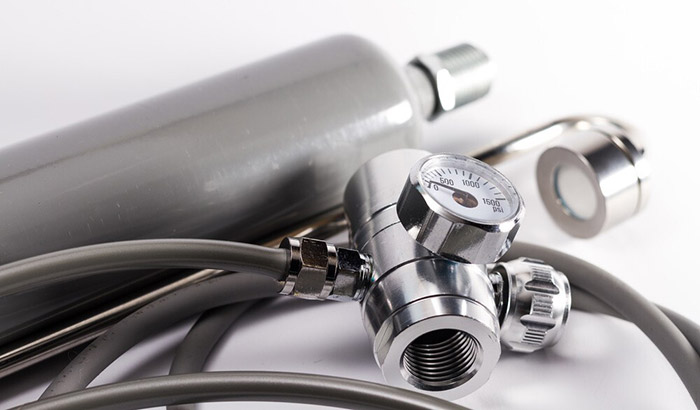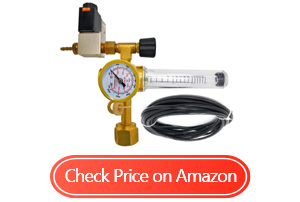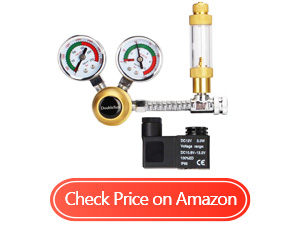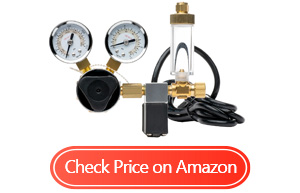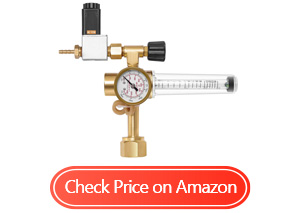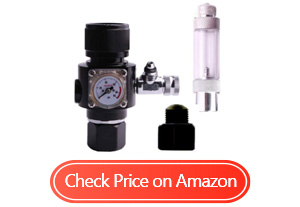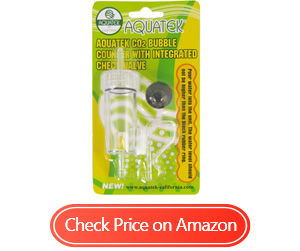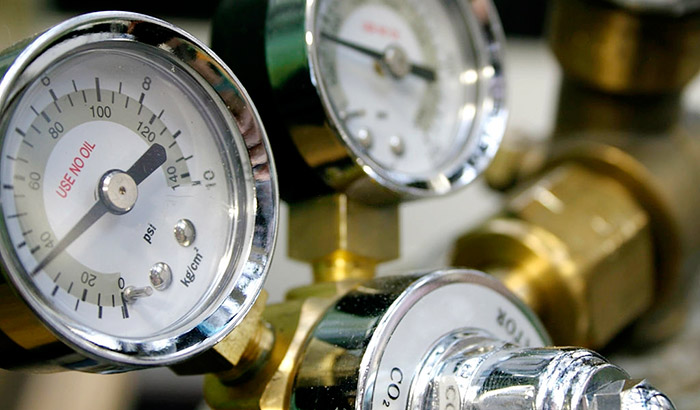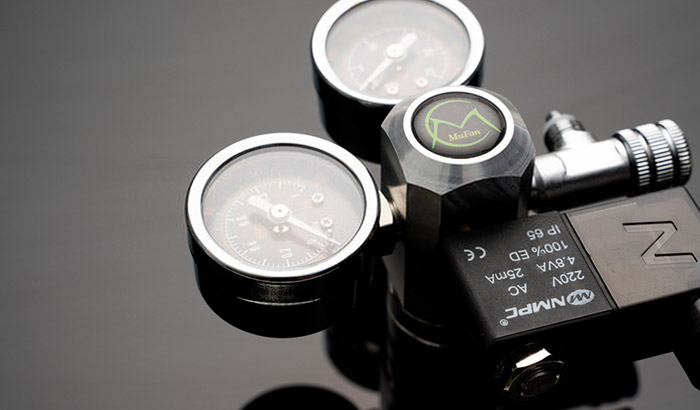No, you don’t simply put a rubber hose on a CO2 tank, place the other end in the aquarium and turn on the gas. For one thing, you can easily oversaturate the water with carbon dioxide, which will kill all of your fish. You will need aquarium CO2 regulator to ensure that the delivery of the gas is smooth and under control.
The best aquarium CO2 regulator allows you to set the rate of delivery of the gas at a constant pressure. You may think that you don’t need a regulator and you can simply crack open the valve a tiny bit to keep the pressure low. It will not work all the time as the ambient temperature will affect gas pressure and you cannot control that.
This article will teach you how to pick the best CO2 regulator for planted aquariums. You will learn the features to look for and what you have to avoid. You will also be getting a couple of product recommendations to help make your shopping experience a bit easier.
Contents
Best Aquarium CO2 Regulator Reviews
1. MANATEE Hydroponics Emitter Co2 Regulator
If you are strapped for cash but need a cheap, yet somewhat dependable aquarium CO2 regulator with solenoid, this one fits the bill just fine. I was planning on replacing the one that I was using after a month once I saved enough for a better brand. However, I am still using the Manatee for almost six months and it is still going strong.
Just like other high-quality regulators, this product mainly uses solid brass for its construction. This regulator can withstand high pressures, significantly more than what a conventional tank of CO2 can produce. That said, you should not worry about leaks or ruptures. Even the fixtures are virtually leakproof.
One of the neatest features of this CO2 regulator is that it comes with a solenoid valve, which means you must plug it into a 110v outlet. This makes making precise adjustments in air pressure easier. I have somewhat mastered how to set the pressure using old-fashioned gate valves, but the solenoid valve makes it almost idiot-proof.
Another nice thing about this product is that you will be getting all of the necessary fittings that you will need to have the regulator set up and running. Not only will you be getting all the fittings, but you will also be enjoying extra gaskets and other consumables.
I almost did not buy this regulator after seeing more than one negative Ista CO2 regulator review. It might be due to poor quality control, but I happen to luck out and got a perfectly working unit.
Some people were not so lucky and noticed that this regulator is a bit too big for their aquariums. To say that getting one of these regulators is hit-or-miss is, therefore, an understatement.
- More affordable than the rest
- Made of solid brass
- Easy to adjust solenoid valve
- Comes with all the parts you will need
- Provides a steady stream of CO2 to help plants grow
- A bit too big for an aquarium
This model is actually for aquaponics and may be too large for your tank. On the other hand, if you have a rather large planted tank, like maybe 150-gallons and up, then this might work out for you. You should keep your receipt, though, as a significant number of customers have issues with this product.
2. DoubleSun Aquarium CO2 Regulator
A neat feature of this CO2 regulator is that it comes with dual pressure gauges. One gauge monitors the gas pressure inside the CO2 tank, which is quite helpful as it will tell you when the contents are starting to get low, so you can get a full tank ready. The other gauge monitors the pressure coming from the outlet.
This CO2 regulator also comes with a split-type, dual-stage solenoid valve. This means that there are fail-safes that will protect your planted aquarium. The dual-stage configuration makes sure that the solenoid valve is letting out just the right amount of CO2 and at the right pressure.
Another convenient feature of this regulator is the built-in bubble counter. With this, you can fine-tune the rate at which the regulator releases CO2 into the water. This means that you will be able to monitor, in real-time, how much CO2 is going into your tank, making it possible for you to tune down the regulator immediately.
It does not matter what kind of diffuser you plan on using as this regulator will be compatible with it regardless. It uses the same standard rubber tubing that most CO2 diffusers use. The same goes for the CO2 tanks. If your CO2 tank follows US standards, then it is compatible with this regulator.
This regulator could have gotten higher marks from me had it been easier to adjust. I have a bit of a problem with the needle gauges as they are quite finicky and seldom want to stay in one place. It will take quite a bit of fiddling to make the needle steady.
- Comes with a dual gauge display
- Has a split-type, dual-stage solenoid valve
- Comes with a built-in bubble counter
- Compatible with a wide range of tanks and diffusers
- Has all the fixtures that you will need to get it started
- The needle gauge is finicky and hard to set accurately
Although this is not the best CO2 system for planted aquariums, this regulator is still one of the most accurate, and not to mention the safest, in the market. If you are a stickler when it comes to every detail about your planted aquarium, you will surely like using this CO2 regulator.
3. Milwaukee MA957 Dual-Valve CO2 Regulator
I liked the dual gauge design. One of the gauges monitors the pressure inside the tank, so when the pressure drops, you will know that you need to get a replacement tank ready. The other gauge measures the pressure going out of the output valve. This helped me fine-tune the flow of the CO2 going into my tank.
Another neat thing about this regulator is that it comes with an electronic solenoid valve, which allows the user to connect the regulator to a timer or controller. This made it a lot easier for me to automate my aquarium. I programmed my regulator to turn on along with the LED lights.
There is also a built-in bubble counter and I use it to further fine-tune the settings of the regulator. The bubble counter is so clear and easy to read. Although it does kind of slow down whenever the solenoid turns on, it will normalize after a couple of months.
This regulator is also quite easy to set up and use. This device is compatible with almost all kinds of CO2 tanks made in the USA. You can even use it with the disposable CO2 tanks without any issues.
I don’t have this issue because I only have a small tank and I use a different diffuser. However, if you are using a high-pressure diffuser, you need to choose another regulator other than this. This regulator cannot even handle fine air stones. On the other hand, if you don’t have a diffuser yet, you can use this regulator with a regular glass diffuser.
- Has two gauges for precise controls
- Comes with a built-in solenoid valve
- Has a built-in bubble counter
- Made of solid brass
- Easy to set up and compatible with almost all CO2 tanks
- Not ideal for use on high-pressure diffusers
Although it is a shame that you cannot use this with high-pressure diffusers, if you don’t have that large of a tank, this would suit your needs nicely. This might not be the best dual-stage CO2 regulator, but it is still serviceable.
4. VIVOSUN Hydroponics CO2 Regulator
What I liked the most about this CO2 regulator for planted aquariums is that it mainly uses solid brass material, which is rust-proof and extremely durable. With regular maintenance and correct use, you can use this regulator for many years to come. I have been using mine for more than six months, and so far, it is still working quite well.
The solenoid valve, as far as I can tell, is above average. I put this regulator on a controller with the lights of my planted tank, and the electronic solenoid valve worked well with the timer. I also liked that the solenoid is still cool to the touch even after hours of use.
The pressure gauge is also a nice size and the face is printed clearly, which makes it easy to read. If you are a stickler for control, you will love this gauge. This makes it much easier to monitor the gas pressure as you will see even the smallest drop in value.
I first thought that this regulator was going to be troublesome to use, considering that it was so affordable. I got this because I needed a cheaper replacement for my old regulator, and I just needed it to last until I saved enough money. Imagine my surprise when I noticed that this was almost as good as the pricier brands.
As much as I liked using this regulator, it does have a couple of minor issues. The most notable one is that it is a bit hard to adjust the needle valve. You will need to turn it up almost to the maximum setting.
After that, you will have to dial it down gradually until you get your desired number of bubbles on the counter. This is not too troublesome but it can get annoying sometimes.
- Made of solid brass
- Has a decent solenoid valve
- Easy to read pressure gauge
- More affordable than most regulators
- Provides smooth and consistent CO2 flow
- Kind of hard to get a consistent gas flow
Although this regulator may need a bit of tinkering to get it running right, I can still say that it is quite reliable when you do manage to get it going. On the other hand, if you are not that handy with tools, you should save a bit more money and get a more reliable brand.
5. FZONE CGA320 V3.0 Aquarium CO2 Regulator
I liked the overall design of this regulator. It is so small and compact, so it pairs nicely with small CO2 tanks. I am using this regulator on a small paintball gun CO2 tank with the help of the included adapter, and the whole setup looked like they were made for use together. The compact size also looks good on the larger, conventional CO2 tanks.
Unlike the other regulators I tested, this one is relatively easier to adjust. The needle valve is not as tricky to adjust as with the other products I used before, which was a nice surprise. This is thanks to its dual-stage design that prevents changes in pressure to affect the overall flow rate.
The Fzone aquarium CO2 regulator kit also comes with its bubble counter so you do not need to buy a separate one. You can also use it in conjunction with the one you already have to get a more accurate reading. I was quite impressed with the included bubble counter. It is accurate, compact, and quite durable.
Not only will you be getting all the necessary plumbing fittings you will need to install this regulator, but it also comes with all the tools needed. However, even though the wrench that came with this regulator worked as intended, I still used the one in my toolbox as it is much easier and less likely to strip the bolts.
I did have a bit of an issue with the bubble counter and it’s not with how it works. The problem is that once installed on the regulator, it can be quite difficult to remove. I had to use a pair of tongue-and-groove pliers to remove the component carefully without breaking the glass.
According to more than one Fzone CO2 regulator review, I was not the only one who had this problem.
- Has a compact design that is perfect for small tanks
- Easy to adjust
- Comes with a bubble counter
- Compatible with different kinds of tanks
- Features all the tools you will need
- The bubble counter is difficult to remove once installed
This is one of the best CO2 regulators I have tried so far. I especially liked that it can accommodate different kinds of CO2 tanks, even the ones used for paintball guns. This is not a perfect regulator by any means, but it is up there with the best.
6. AQUATEK Basic CO2 Regulator
Of course, you would like all components in your aquarium to last at least a couple of years, and that is what you will get from the Aquatek regulator. The biggest reason why this regulator is so durable is that it uses solid brass for its primary material.
This means that this regulator is rust-proof and can handle high pressure. I have only been using mine for a couple of months but I haven’t had any issues with it yet, which is a good sign that it is indeed durable.
Another nice thing about the Aquatek mini CO2 regulator is the durable solenoid valve. Having an electronic solenoid valve means that the regulator is ideal for use with a timer so you don’t have to turn it on and off every day. Another thing I liked about the solenoid valve is that it remained quite cool even after running for a couple of hours.
This dual-stage CO2 regulator aquarium kit also comes with a free bubble counter, which you can choose to use or not. I kind of like how the bubble counter works. It also has a check valve to prevent backflow into the tank. Moreover, the kit came with the tools that you will need to install the regulator, including a couple of extra seals
The best thing about this regulator is that it is quite affordable for a dual-stage CO2 regulator. This is almost half the price of the top brand regulators, but it works almost the same. If you’re strapped for cash but still want the best for your planted tank, this is your best option.
Now, you will get what you pay for with this regulator. It does work well, but certain features could have been made better. One of the issues I had with this regulator is that it has a finicky needle valve. I had to turn it up quite high and then slowly dial it down to get the right setting.
- Made of solid brass for added durability
- The solenoid valve works well with a timer
- Affordable price for a dual-stage regulator
- Does not need constant adjustments
- Comes with a free bubble counter
- The needle valve is finicky and hard to set
If you are the kind of person who does not like to adjust the valves constantly, this is also not the type that you just set once and then leave. This is a regulator that is great for beginners at keeping a planted tank. The good thing about it is that it is quite affordable while still having decent quality overall.
What to Look For When Buying a Aquarium CO2 Regulator
If this is the first time that you are taking care of a planted tank, and you are not versed in the components that make up the system, you may not know what kind of CO2 regulator to use. To help you shop, here are some of the factors to consider:
Durability
Of course, you would like to buy a regulator that will last for as long as possible, so pick one built with quality in mind. If possible, get one made from solid brass.
It is the standard material for gas plumbing because of its innate toughness and its high corrosion resistance. In the absence of solid brass, solid aluminum will suffice.
Ease of Use
You may think that setting a regulator is easy but you may be wrong, especially if you use a poor quality one. Almost all the cheaply-made regulators are quite difficult to set.
I used a cheap regulator once, and it took me almost half an hour just to dial in the right pressure. It was very difficult to get the needle valve steady. That said, make sure to dedicate some time assessing how easy it is to use a specific regulator before buying.
Compatibility with CO2 Tanks
Check if the regulator you are planning to buy is compatible with as many different CO2 tanks as possible. This is in case you cannot buy the regular CO2 tanks for whatever reason that may arise.
The regulator should fit not only in all standard CO2 tanks but also on disposable CO2 tanks. They should also come with an adapter for smaller tanks, like those used for paintball.
Automation-Ready
Some old-school regulators only come with a gate valve. However, modern ones now use an electronic solenoid valve, which is more reliable and convenient.
Because solenoid valves require electricity to remain open, you can plug the regulator into a programmable controller or timer. That way, it will turn on and off at certain times of the day so that you do not have to.
Automating even just a couple of the tasks involved in keeping an aquarium will make the hobby even more relaxing and rewarding than it was before.
Cost
You will first need to figure out what kind of budget you will be working with. There are plenty of CO2 regulators in the market that is quite cheap. Some are less than $10 each. However, will you trust a cheap CO2 regulator to keep your expensive hydrophytes and fish safe?
On the other hand, if you have no other choice other than to use a low-cost CO2 regulator, you have to do your homework. Read as many aquarium CO2 regulator reviews as you can. With that, you can be sure that you won’t be wasting your money because you are constantly replacing your cheap regulator.
Frequently Asked Questions
How to Read a CO2 Regulator Aquarium?
If you have a single gauge regulator, the dial will show you just the remaining gas pressure in the cylinder. On the other hand, if you have a dual-gauge aquarium, the right gauge will show you the pressure in the tank.
Meanwhile, the other one will show you the working pressure. The working pressure is the force applied to the solenoid and needle valves. It essentially tells you how much CO2 is being delivered into your aquarium.
How to Adjust an Aquarium CO2 Regulator?
To increase the output/working pressure, you need to turn the adjustment knob (located at the center of the regulator) to the left and to the right to decrease it. For more precise adjustments, turn the needle valve (the one beside the bubble counter) clockwise or counterclockwise.
Watch the bubble counter while adjusting the needle valve so you can get the flow rate you want.
Conclusion
If you will be keeping a high-tech planted tank, use a proper CO2 delivery system, and at its core is the best aquarium CO2 regulator. Just as the name states, a regulator will control the rate at which carbon dioxide goes into your planted tank.
It is important as too much carbon dioxide will not be good for the fish and other denizens of your planted tank.
Now that you reached the end of this article, you already learned what to look for when shopping around for the best co2 regulator for planted tanks. Aside from helping you get the best that your money can buy, it will also encourage your plants to grow and thrive.

